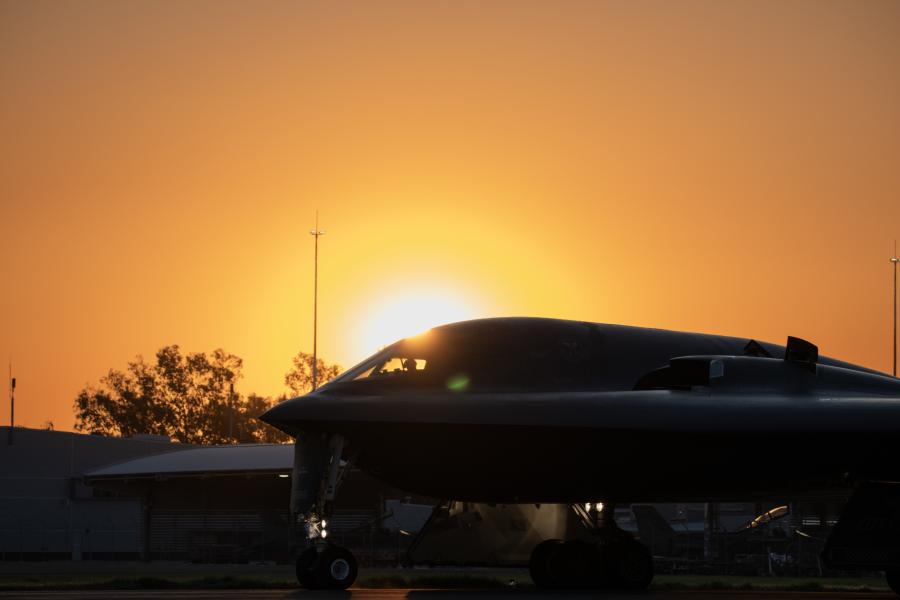The Air Force is keeping the momentum going with its bomber deployments in Australia, with regional allies increasingly “welcoming” them as a strategic counterbalance to China’s growing assertiveness.
“We continue to build up the infrastructure at [Royal Australian Air Force base] Tindal, I got to see that with my own eyes,” Gen. Kevin B. Schneider, commander of Pacific Air Forces, told reporters at AFA’s Air, Space & Cyber conference. He added that the command is closely working with the Air Force Global Strike Command to find “the right times” to bring out bomber deployment to the theater.
This follows Secretary of Defense Lloyd J. Austin’s announcement last month that the U.S. would increase rotations of bombers and maritime patrol aircraft across Australian bases. The Pentagon is investing in Australia’s base infrastructure, with plans for facilities that could house up to six B-52 bombers and refueling aircraft at RAAF Tindal to project power into the South China Sea.
“The heavy-handedness of what Beijing is doing around the region is opening a lot of doors for us, so we continue to look for other opportunities, as other partners in the region look to have greater interaction with the United States Air Force and are welcoming the bomber presence,” added Schneider.
Last month, three B-2 Spirits deployed to RAAF Amberley for the first time since the summer of 2022. Accompanying them were over 180 Airmen from the 110th Expeditionary Bomb Squadron and two KC-135R tankers from the Illinois National Guard.
The stealthy bombers flew 34 sorties, engaging in joint exercises with RAAF F-35 Lightning IIs, F-18 Super Hornets, EA-18G Growlers, KC-30A tankers, and E-7 Wedgetails across southeastern Australia. The squadron made a pit stop at Diego Garcia and Guam, coordinating with U.S. tankers, including KC-46s and KC-135s. The mission also included one of the bombers conducting joint training with four Japanese F-35As over the Pacific Ocean for the first time. The bomber trio is back at Whiteman Air Force Base as of last week, a base spokesperson confirmed.
“The presence of the B-2 and our Airmen highlights the ongoing commitment to security and stability in this region,” Lt. Col. Justin Meyer, 110th EBS commander, said in a release.
The B-2 crew also collaborated with the RAAF Marine Rotational Force stationed at Darwin Base to conduct inert bombing runs—exercises that involved dropping nonexplosive munitions to improve targeting and coordination.
Schneider also noted that Pacific bomber missions focus on enhancing “maritime strike capabilities” by working closely with Air Force Global Strike Command.
“We work with Gen. [Thomas] Bussiere and his team to continue to evolve the anti-ship capability, whether it’s through the platforms towards the weapons, the tactics, techniques and procedures,” said Schneider.
While all three bomber aircraft can be equipped with the Long Range Anti-Ship Missile (LRASM), the B-1 stands out for its speed and large payload capacity. The B-52 Stratofortress, capable of carrying a wider variety of anti-ship missiles than the Lancer, including both the LRASM and the AGM-84 Harpoon, also remains a key option for sea-based attacks.
“We’re in the business of sinking ships,” Schneider said, noting that his area of responsibility continues to witness Beijing’s unsafe behaviors at the highly contested Second Thomas Shoal “on a regular basis.”
In May 2024, a Chinese J-10 fighter dropped flares in front of a Royal Australian Navy MH-60R helicopter operating from a navy warship. This took place in international airspace over the Yellow Sea while the helicopter was on a United Nations mission enforcing sanctions against North Korea. The Australian officials labeled the incident “unprofessional,” leading to a formal complaint to China.
Last month, Beijing’s Y-9DZ electronic intelligence collection plane came within 12 nautical miles of Japan’s Danjo Islands, located 80 miles west of Kyushu, Japan’s southernmost main island. Japanese officials deemed the incursion “utterly unacceptable” as this marked the first time a Chinese military aircraft had violated sovereign Japanese airspace since Japanese Self Defense Force began tracking such incidents in 1967.

